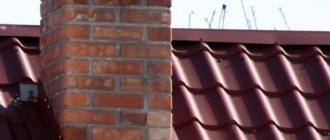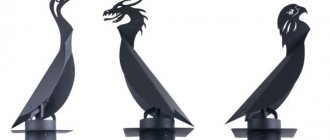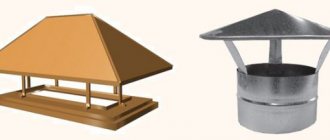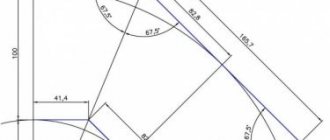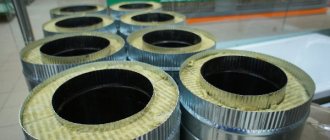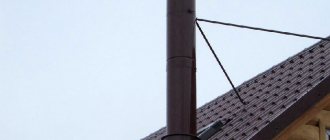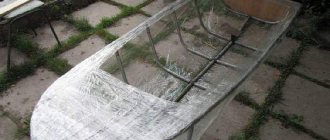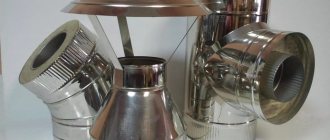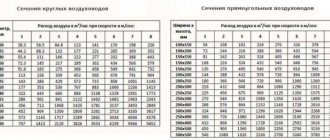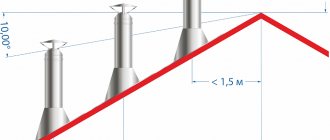Fireplaces have become popular recently, and when installing them, many people have the question of how to make a chimney chimney, and how necessary it is. Not a single fireplace, unless it is made for beauty, can do without chimneys and pipes. And of course, in this situation it is impossible to do without such a necessary attribute as a cap, which is supposed to protect the pipe from precipitation.
Various options for a chimney pipe
A chimney on a brick chimney is an ancient element of architecture, the presence of which on the roof of a house indicates that the owners have refined taste.
It is worth noting that, having caught this trend, manufacturers offer a large number of pipe covers of different configurations, and you can buy products in the store to suit your taste.
But some home owners prefer to do everything themselves. Before you start manufacturing, you need to understand not only the design of this decorative element, but also what material to use to create a chimney for the pipe.
Purpose of the cap on the chimney pipe
We all play our part in this life.
So a weather vane is necessary in order to increase draft, deflecting air currents and thereby maintaining a bright flame and warmth in your home. In addition, the deflector also protects the chimney from atmospheric and climatic phenomena such as slanting rain and snowfall. Ancient traditions of the East say that the chimney is the upper gate of the house, and therefore requires no less protection than the front door.
Thanks to the cap on the chimney pipe, you can prevent debris, birds and their nests from getting into it. This is precisely why a mesh is installed, preventing unwanted clogging, but allowing smoke to pass freely from the chimney.
Let's list all the functions of the cap on the chimney pipe:
- Function of increasing draft in the chimney;
- Up to 20% higher efficiency of your chimney pipe;
- Protective function against debris and weather conditions;
- Preventing the destruction of a brick chimney.
The best draft is achieved by chimneys with a pipe that has a series of revolutions, and not with a pipe with a straight stroke.
Step-by-step description of the installation process
It is very important to take a responsible approach to installation, since it depends on it whether the chimney will perform its functions. Otherwise, there is a risk that it will simply become a decoration for the roof.
It is important that the assembly conditions comply with safety regulations. You should work in shoes with soft soles so as not to damage the roofing material. Wear a thick robe, gloves, and prepare a fastening for the safety rope.
Sequencing:
- Prepare holes in the apron for fasteners. Diameter – from 5 mm, pitch – 15 mm.
- Place the weather vane on the chimney and secure it. Using a form, drill holes in the chimney.
- Remove the chimney.
- Place dowels under the screws into the holes.
- Install the weather vane on the pipe so that the holes match and secure with self-tapping screws.
For additional fastening strength, it is recommended to install a steel clamp and crimp it. To check the reliability of installation, tap with a hammer along the perimeter of the apron, this will help to understand whether there is any displacement under loads; you should also press with your own weight on the cap.
For reliability, metal surfaces are covered with a protective coating selected depending on financial resources, conditions of use and decorative properties.
All variety of weather vanes
Today, craftsmen offer us from standardized caps to the most unusual, unique and custom-made ones. It simply doesn’t make sense to disassemble each of them. Let's look at the main categories of caps:
- Standard chimney cap. It looks like a hipped roof of a house. One of the most common.
- Chimney umbrella. It has a cone shape.
- A weather vane with a flat top.
- A cap with a semicircular finial.
- Chimney cap with gable roof. In this case, there are two slopes per pipe.
- A cap with a weather vane on the top of the chimney. Has the greatest scope for realizing your fantasies.
- Chimney cap with opening lid.
Various design features and different materials give weather vanes only some distinctive features and additional characteristics. Otherwise, they all perform the same functions and play the same role. When choosing a form, it is rather the sense of taste that is important. It is difficult to say that one of the designs will be much better than all the others.
Types of chimney caps
Flat copper finials, for example, are most often installed on Art Nouveau houses. European style houses are best combined with semicircular caps. Gable roof hoods are best installed in snowy regions where winter rainfall is above average.
Vane vanes are also good because their design allows you to install a damper specially designed for this purpose and, during strong winds, combustion products can freely leave the pipe of your chimney without polluting it. This means you'll have to clean your chimney less often.
Returning to cleaning, it should be noted that a chimney with an opening lid will be most convenient in this regard, because it allows for unhindered cleaning, since it does not block the chimney pipe when open.
Where to buy or order
If you are looking for where to buy a ready-made forged roof product or order its individual production according to your personal sketches, we suggest taking a look at the corresponding section of our blacksmith catalog. The section “Where to buy and order forged chimneys” contains companies offering items that are simple in design and original in execution. All products are of high quality, wide range and reasonable prices.
In conclusion, it is worth noting that forged caps last much longer than metal or galvanized ones due to the technical characteristics of forged metal. Thanks to the decoration with openwork elements, they give the buildings uniqueness and originality. If you want to draw attention to your home, be sure to install a wrought iron weather vane on your chimney.
How does a chimney cap work?
The air flow hits the wall of the upper cylinder, bending around it from all sides.
Sliding along the surface of the cylinder, the air stream turns upward, at this time sucking in the smoke that comes out of the pipe.
When air moves inside the pipe, its intensity increases, resulting in an increase in draft, which is especially important if you have a gas chimney.
If the wind flows are directed at an angle or vertically, and not horizontally, then the cap also plays its role in increasing traction. Penetrating through the gap into the upper cylinder, wind currents suck smoke into the chimney.
If the wind under the hood is low, then the formation of vortices may begin, slowing down the exit of smoke.
In the case of a low wind, the installed reverse cone helps to reflect air currents with smoke, cut them and bring them out.
Pay maximum attention to the selection and installation of the weather vane. Do not forget that the successful operation of your chimney begins with the correct design and choice of material, and ends with the canopy on the chimney pipe, which is no less important. Having fulfilled all the requirements once, you will be able to enjoy the smooth movement of the flame in the hearth for many years, only maintaining cleanliness and order from time to time.
- Alexander
Purpose and types of chimney canopies
As for the protective properties of umbrellas, not everything is as simple as is commonly believed. For example, when talking about the purpose of various nozzles, among other functions, protection of chimney pipes from condensation is mentioned.
Pipe cap
This statement is incorrect, since condensation forms inside the pipe from the temperature difference between the combustion products and the outside air, and the umbrella is located outside and has nothing to do with this process.
Why then are visors needed? We list their main functions:
- give the outer section of the pipe an aesthetic appearance;
- protect the internal cavity from the entry of various debris and foreign objects;
- extend the service life of a brick chimney, protecting it from precipitation;
- increase the draft and do not allow it to be overturned by strong gusts of wind, provided that the design of the hood provides for this.
In fact, decorative caps in no way improve the draft of the chimney; on the contrary, they create additional resistance to the flow of emitted gases. The exception is two types of nozzles:
- similar to industrial exhaust deflectors;
- weather vane - deflectors.
The operating principle of the first type is as follows: the air flow from the wind load washes the cylindrical deflector casing, which causes a slight vacuum to appear inside it.
Air flow from wind load
It turns out that the umbrella-deflector still increases draft, although in the absence of wind it, on the contrary, creates even greater resistance to flue gases. How it works is shown in the pictures:
Chimney cap
The second type is much more effective. The body in the form of a half-cylinder with a weather vane petal can rotate on the pipe due to the bearing. The petal ensures that the body is positioned so that it is always turned “with its back to the wind.” Thus, a vacuum is formed inside the half-cylinder and the smoke draft increases. In addition, such a chimney cap 100% protects it from the effect of overturning the draft when blown by the wind. The operating principle is shown in the diagram:
Body in the form of a half-cylinder with a weather vane petal
History of appearance
If you look into the past, you can see that the history of the development of chimneys began with wooden structures; they were short-lived and fire hazardous. On the one hand, they rotted from precipitation, and on the other hand, they burned from the flames escaping through the chimney. Most often they had the shape of a house. Later, an aesthetic component began to be added to this house, the houses became more refined and beautiful.
Later, a mechanical component was added and weather vanes appeared, which had a chimney as a base and were one with it. In addition to their main purpose, weather vanes and chimneys indicated the direction of the wind. In addition, the chimney indicated the status of its owner. Later they began to make chimneys for metal pipes, and at the beginning of the last century they were even forged. In their form they were single-tiered and multi-tiered. Some were real works of art , and specialists in the manufacture and design of chimneys were in great demand.
Types of chimney caps
All other chimney caps are a wide variety of devices that cover the pipe section with a certain gap for the combustion products to escape. The variety of forms is so great that it is simply impossible to list them all.
Metal cap with powder painting
But the list of materials from which the visors are made is not so long:
- galvanized (roofing) steel;
- galvanized metal with polyester powder coating;
- stainless steel;
- copper;
- titanium and zinc alloy.
The simplest do-it-yourself chimney umbrella is most often made of galvanized steel up to 0.8 mm thick. This is the most affordable option, and the product lasts quite a long time - at least 20 years. There is only one drawback - the galvanized surface quickly fades from exposure to the external environment and the umbrella does not look very aesthetically pleasing. Powder-coated metal does not have this drawback; caps are also often made from it, although the cost of the material is somewhat more expensive.
Copper cap
About other materials, it is only worth saying that they retain a presentable appearance for a very long time, and the service life of products made from them is measured in decades. Although copper also gradually tarnishes in the open air. The disadvantage of stainless steel, copper and alloy is their significant cost. Exclusive products with forging elements and weather vanes will cost even more.
DIY chimney cap
With your own hands
You can make a roof chimney yourself if you stock up on consumables, equipment and free time. To manufacture it you will need the following equipment and tools:
- metal scissors;
- mallet;
- hammers of different shapes;
- metal corners for fastening.
The materials you can use are sheet metal and ready-made forged elements.
In addition, performers who do not have the relevant knowledge are recommended to obtain it. To do this, you need to master forging operations. Long-term training in blacksmithing in an educational institution, on your own, in master classes, ensures the acquisition of a wide range of skills.
Reference. You can purchase decorative parts for chimneys and other metal products from employees of manufacturing and trading enterprises, which are collected in the “Where to buy forged elements” section.
Assembly of the chimney (hood), artistic forging, welding and painting with your own hands
Some secrets are presented in the following video.
- The chimney is made from four triangles, which are welded to form a pyramid-shaped product.
- To decorate the product, a peak with a texture is attached to the top.
- To avoid distortion, a homemade box (conductor) is used, located on the table.
Recommendations for selection
Oddly enough, first of all, the choice of hood depends on the type of boiler installation and the type of fuel burned. For example, nozzles on chimneys serving gas boilers can be installed in only one design - in the form of a nozzle, with an open top.
Important! Regulatory documents of the Russian Federation and Ukraine strictly prohibit the installation of all kinds of umbrellas on the chimneys of all gas-using installations. It is possible that similar restrictions exist in the regulatory frameworks of other countries, so before purchasing an attachment you should pay attention to this in order to avoid troubles.
Open top nozzle
Such prohibitions are explained very simply. At negative temperatures, the chimney cap will begin to freeze and become covered with a layer of ice. The latter will gradually block most of the working opening, the smoke will have nowhere to go, and the draft will sharply decrease. The result is that fumes go inside the house, and people’s lives are in serious danger. Below is a photo where the icy umbrella is clearly visible:
Icy chimney umbrella
The reason is condensation that forms on cold metal upon contact with low-temperature combustion products. This is the temperature of smoke from boiler plants with high efficiency, that is, gas ones. Because of this, it is prohibited to place a cap on a brick chimney pipe. It’s another matter when the boiler is solid fuel, its efficiency varies between 70-80%, and the outlet gas temperature ranges from 150 to 250 ºС. Here you can safely select a nozzle, especially for a brick channel that is destroyed by precipitation. Just remember that it will quickly become covered with black soot.
Note. Pellet boilers running on high-quality fuel can also achieve an efficiency of about 90%, so it’s better not to risk it and use an open nozzle as a canopy on the pipe.
When the issue of boiler installations is clarified, let’s move on to the gas exhaust pipe itself. The easiest way is if it is assembled from a three-layer modular sandwich, then protecting the chimney from rain is not required at all. The ingress of precipitation into the channel even benefits it; the pipe is washed from the inside, and then the water is discharged into the condensate collector. For a gas boiler we choose a nozzle, for a solid fuel boiler - any other nozzle, preferably from a technical point of view - a deflector-vane.
What about a brick pipe? No problem, when it serves a solid fuel boiler, you can choose a cap from any material and any shape you want, according to your means. If the combustion products are removed from the gas boiler through the channel, then the umbrella cannot be placed on the chimney pipe at all, and the constant entry of moisture into the channel destroys the material. Nevertheless, there is a way out of this situation; to be convinced of this, just look at the photo:
Chimney protection box
Here you can clearly see that the cap is made as a protective box that completely covers the brick base. Since the photo shows a pipe with several channels, some of which are ventilation, the pipes and umbrellas used are different. But nozzles are installed on the chimney ducts in accordance with the standards.
Dymnik today
Currently, expensive and heavy predecessors have been replaced by products made from lighter and more reliable materials. Smoke chambers made of copper, stainless or galvanized steel appeared. In addition, with the help of special paints, it is even possible to use computer-aided design to match the color of the roof. There are entire databases of different shapes and types of smoke chambers. And by looking at these bases, you can order not only a ready-made model that you like, but also come up with your own original version.
It is important that the selected chimney corresponds to the functionality of the specific chimney and the roof as a whole. In addition, it must match the style of the building. Today this service is so relevant that it can be found in almost any city. It is better to choose a company where consulting engineers will not only answer all questions, but also help you make the right choice.


